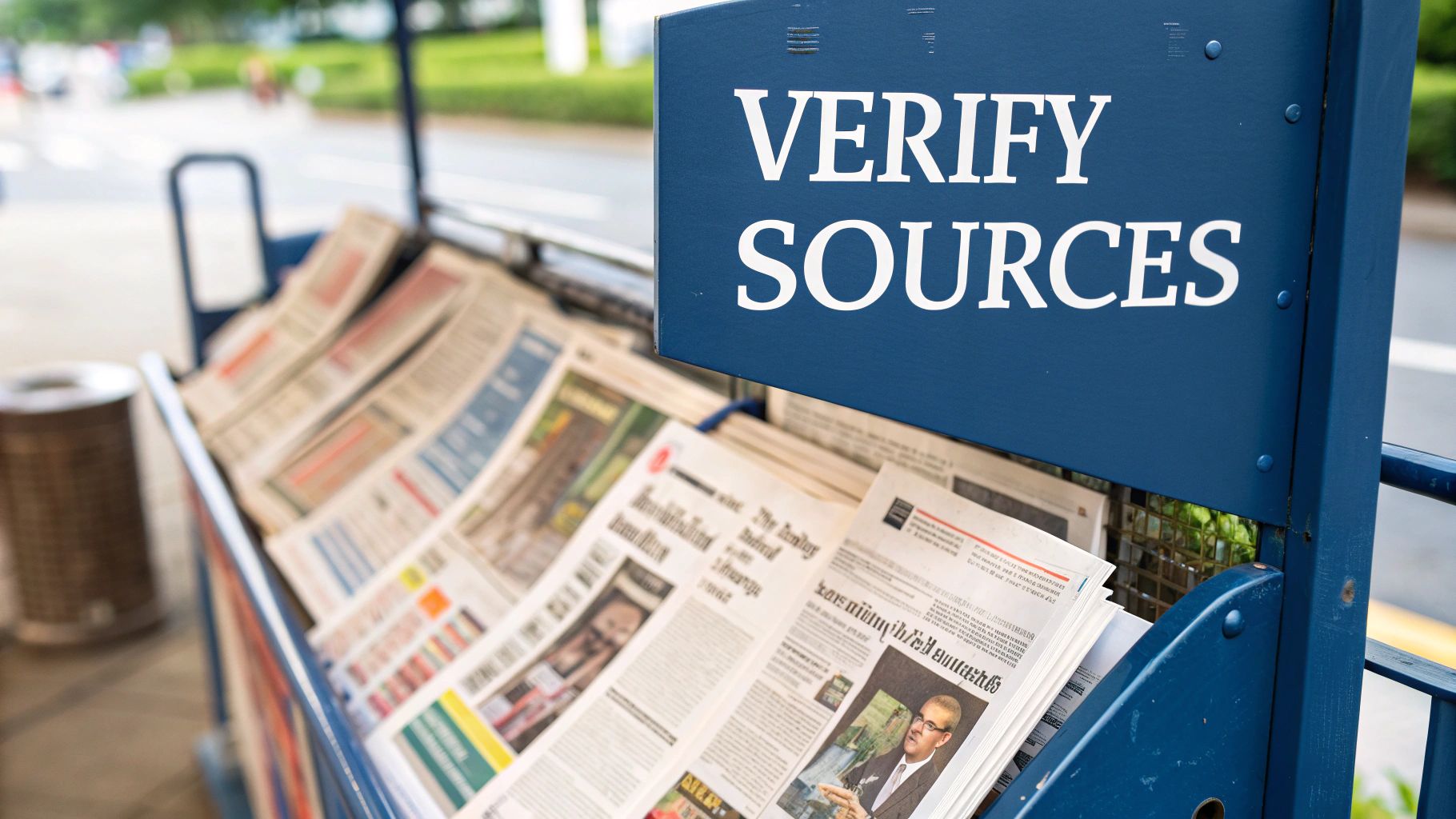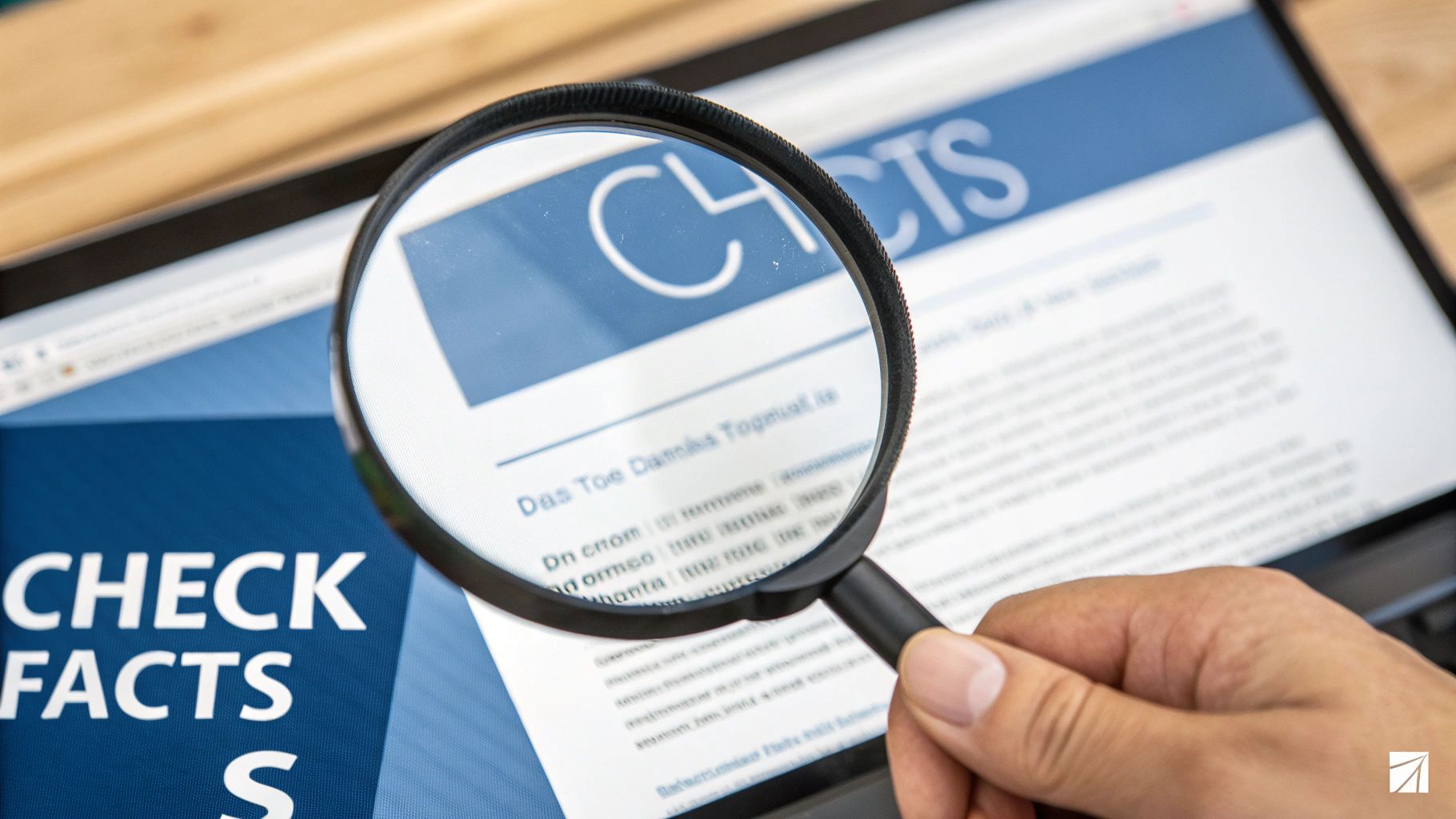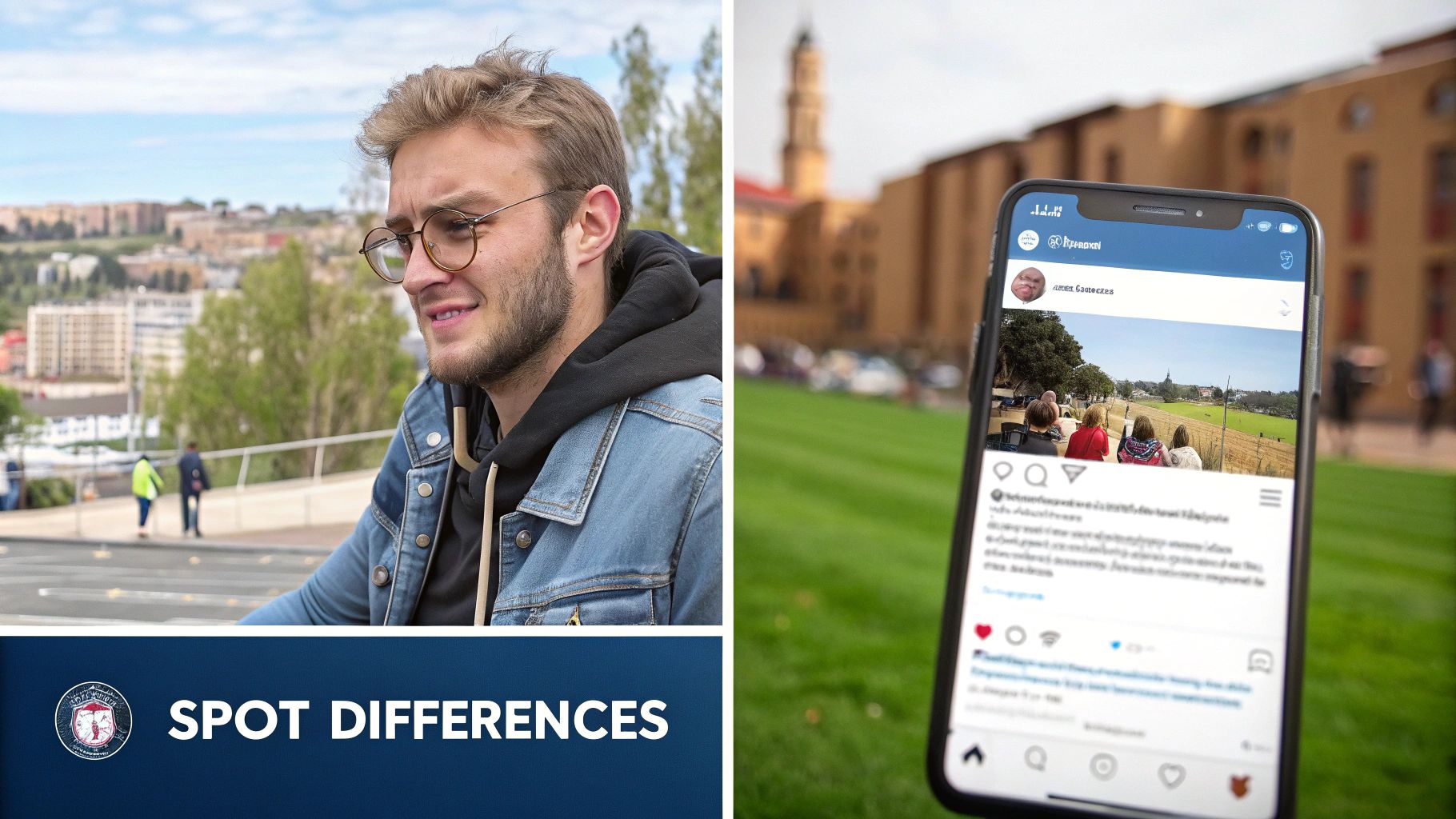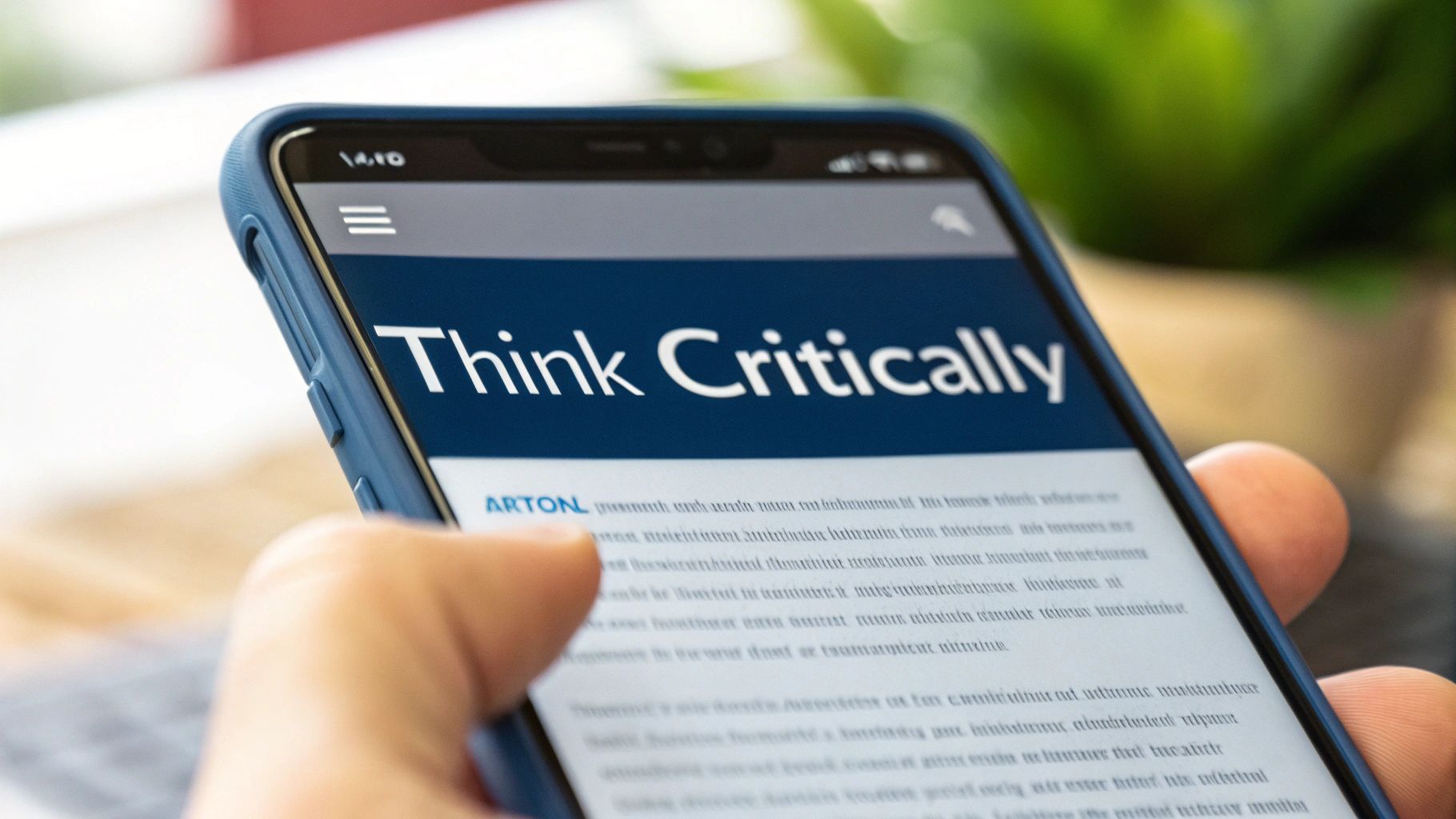How to Spot Fake News: A Research-Based Guide for Digital Citizens
Understanding the Scale and Impact of Misinformation

Fake news and misinformation have become major challenges affecting communities worldwide. When false information spreads online, it can shape public views, sway voters, and even spark real-world conflicts. To protect ourselves, we first need to understand just how widespread this problem has become.
The Pervasiveness of False Information
The numbers paint a concerning picture: 48% of people across 27 countries have fallen for fake news at some point, initially believing false stories to be true. In some regions, the problem is even more severe – for example, 62% of people in Brazil report having believed fake news. These statistics highlight why we need better tools and education to spot false information. For more data on this topic, check out these detailed fact-checking statistics.
How Misinformation Spreads
Social media plays a key role in how fake news travels. The platforms' engagement-focused algorithms tend to boost content that gets strong reactions, whether true or false. As a result, sensational and emotionally-charged stories often spread rapidly, even when they contain wrong information. This creates an environment where users must constantly evaluate what's real and what's not.
The Impact on Decision-Making
When people believe and share false information, the effects ripple through society. Misinformation can cloud our understanding of key issues and lead to poor choices that affect our health, politics, and communities. For instance, when fake news about medical treatments spreads, it can cause real harm – like when false vaccine claims lead to disease outbreaks that could have been prevented.
Vulnerable Demographics and Disinformation Campaigns
Some groups face higher risks from fake news than others. Older adults may struggle more with online information sources and be more likely to trust what appears official. Bad actors know this and often create targeted false content designed to exploit specific groups' existing views and concerns. Understanding these tactics helps us better protect our communities from those who spread lies for their own gain.
The Evolution of Digital Media Literacy
The way we get our information has changed dramatically since the rise of social media and online platforms. While these changes brought easier access to knowledge, they also created perfect conditions for fake news to spread quickly. As a result, we've had to develop new skills – what we call media literacy – to tell fact from fiction online.
From Traditional Fact-Checking to Digital Verification
In the past, fact-checkers relied on tried-and-true methods like checking official documents, calling up experts, and verifying sources directly. These approaches still work well today. But with news spreading at lightning speed online, we need additional tools in our toolkit – specifically, digital verification skills.
One great example is using reverse image search to spot photos that have been altered or taken out of context. Other helpful techniques include examining website addresses for red flags and comparing how different reliable sources report the same story. These digital detective skills are essential for catching fake news as it races across the internet.
Adapting to New Challenges: Social Media, Deepfakes, and AI
Today's information environment is more complex than ever before. While social media helps us stay connected, it can also spread false information like wildfire. We now face sophisticated threats like deepfake videos that look amazingly real but are completely fake. Adding to the challenge is AI-generated text that can create believable but false stories.
To tackle these new challenges, we need to look beyond just checking sources. This means learning to spot logical flaws in arguments, recognizing when content tries to manipulate our emotions, and understanding the full context of what we're seeing. These skills build on decades of media literacy work – from analyzing films in the 1960s to understanding advertising and internet content today. The rise of social media has made these abilities more crucial than ever. For a deeper dive into this history, check out this comprehensive guide on media literacy.
The Importance of Critical Thinking
At its core, fighting fake news comes down to critical thinking. This means questioning what we read, examining the evidence, and considering different viewpoints. The goal is to develop a healthy dose of skepticism without becoming overly cynical. These skills help us make smart choices based on reliable information – something that's essential for being an informed citizen in today's world.
Mastering the Art of Content Verification
Learning how to verify online information is essential for anyone who reads or shares content on the internet. This guide will help you develop practical skills to analyze information and spot potential misinformation. Think of these techniques as tools in your fact-checking toolbox.
Deconstructing Fake News Articles
Understanding how fake news works makes it easier to spot. Let's examine the key elements that often appear in false stories:
- Clickbait Headlines: Writers of fake news rely heavily on dramatic, emotion-triggering headlines to grab attention and shares. Watch for overly dramatic language or claims that seem too good (or bad) to be true.
- Emotional Manipulation: False stories frequently target basic emotions like fear, outrage or excitement to override critical thinking and encourage quick sharing without fact-checking.
- Misleading Data: Numbers can be twisted to support false narratives through selective presentation, unreliable sources, or complete fabrication. Always check data against credible sources.
Recognizing Red Flags
Several warning signs can help you identify potentially false content:
- Source Credibility: Check the website or account sharing the information. Be wary of unfamiliar domain names, missing contact details, or accounts known for spreading false claims.
- Writing Quality: Poor grammar, spelling errors, and an unprofessional writing style often indicate unreliable content.
- Image Authenticity: Photos can be edited or used out of context. Use tools like Google Images reverse search to verify if pictures have been altered or misused.
Fact-Checking Like a Pro
Professional fact-checkers use systematic methods to verify information. Here's their basic approach:
- Break Down Claims: Split complex statements into smaller, checkable parts
- Check Multiple Sources: Compare information across several reputable outlets
- Verify Expert Credentials: Research the background and potential biases of quoted experts
For example, when checking a health claim, a fact-checker would find the original research, examine the study methods, and see if other scientists support the findings. Recent data shows interesting patterns in how different groups approach fact-checking. According to Statista's research, younger adults generally feel more confident spotting fake news than older adults, while political views also influence fact-checking confidence.
Identifying Manipulation Tactics
Learning to spot manipulation helps build resistance to false information. Pay attention to how writers use language and images to influence readers' opinions. Study examples of both successful and failed manipulation attempts to better understand these techniques. This knowledge helps you make better-informed decisions about what to believe and share online.
Digital Tools That Make Fact-Checking Easier
Once you understand the basics of verifying content, specific digital tools can make your fact-checking much more effective. These resources help anyone, from beginners to experts, check facts thoroughly and catch false information quickly.
Key Digital Verification Tools
Several helpful tools can boost your fact-checking skills:
-
Reverse Image Search: With tools like Google Images, TinEye, and Yandex, you can find other places an image appears online. This helps spot when old photos are passed off as new or used out of context. For example, you might discover that a photo claimed to be from yesterday's events actually comes from years ago.
-
Image Analysis Tools: More specialized options like InVID and FotoForensics can spot signs of photo editing or manipulation. These tools examine details like file data and pixel patterns to find potential alterations.
-
Fact-Checking Websites: Sites like Snopes, PolitiFact, and FactCheck.org research viral claims and provide detailed reports. They're great for quickly checking if a story has already been proven false.
Creating a Strong Verification Process
The best fact-checkers use multiple tools together in a clear process. First, they identify the main claims that need checking. Then they look for proof from reliable sources. Finally, they analyze any images or videos for signs of tampering. For instance, when checking a news story about scientific research, they'd find the original study and verify what it actually says.
Making the Most of These Tools
Here's how to use digital fact-checking tools effectively:
- Know Their Limits: No tool catches everything. Each has specific strengths, so use several tools together when possible.
- Check the Source: Look into who's sharing the information, not just the content itself. Research their background and potential biases.
- Keep Practicing: The more you use these tools, the better you'll get at catching false information quickly.
Comparing Popular Tools
This table shows key differences between common fact-checking resources:
| Tool | What It Does | Best Uses |
|---|---|---|
| Google Reverse Image Search | Finds other copies of images online | Quick image checks |
| TinEye | Searches for original image sources | Finding first use of images |
| Snopes | Checks viral stories and claims | Debunking common hoaxes |
| PolitiFact | Fact-checks political statements | Checking political claims |
| FactCheck.org | Verifies news and social posts | General fact-checking |
These digital tools give you practical ways to verify information and catch false content. With practice, you'll develop a good eye for spotting fake news. Next, we'll look at how to think critically when evaluating new information.
Developing Your Critical Thinking Framework
Learning to assess information logically and systematically is key for making sense of what we read and watch online. Having a solid critical thinking framework helps us identify misleading content and become more thoughtful consumers of information.
Recognizing Your Own Biases
We all have built-in assumptions and preferences that color how we view information. The first step is acknowledging your own potential blind spots – whether they come from your political views, life experiences, or strongly-held beliefs. For example, if you identify strongly with a particular political party, you might automatically accept information that matches your existing views without examining the evidence carefully. Being aware of these tendencies helps you evaluate content more objectively.
Questioning Everything You Read
Getting into the habit of analyzing information carefully makes a big difference. For every piece of content you come across, ask yourself:
- Who is behind this information and what's their goal? Consider if they're trying to sell something, promote a specific viewpoint, or simply inform.
- What proof backs up these claims? Look for concrete facts, data, and citations from reliable sources rather than anonymous claims or personal stories.
- What other angles exist on this topic? Make an effort to find different perspectives, including ones that challenge your assumptions.
Maintaining Healthy Skepticism
The key is finding the right balance – approaching information with careful consideration without becoming overly cynical. Think of yourself as a detective gathering evidence before drawing conclusions. This means being open to questioning claims while also recognizing that not everything is false or misleading.
Balancing Speed and Accuracy
With news and information moving so quickly online, it's tempting to quickly share content without verifying it first. However, taking time to fact-check, even if you miss being first to share something, helps prevent spreading false information. The most reliable fact-checkers prioritize accuracy over speed.
Critical Thinking Under Pressure
It's especially challenging to think critically when emotions are running high or decisions feel urgent. However, these high-pressure moments are when careful analysis matters most. Having strategies ready – like taking a short break to process information more carefully – helps you stay objective when it counts.
Applying Critical Thinking in Various Contexts
These skills work across different situations, from reading news articles to evaluating social media posts. Building strong critical thinking abilities helps you spot questionable information and navigate online content with confidence. This means learning to identify trustworthy sources and recognize when information might be twisted or misleading. While developing these skills takes practice, the payoff of being a more discerning consumer of information is worth the effort.
Taking Effective Action Against Misinformation
Spotting fake news is just the first step – taking thoughtful action helps create real change. By combining awareness with strategic approaches and respectful communication, you can help build a more truthful online environment. Here's how to make a meaningful impact.
Addressing Misinformation in Your Networks
When you see false information being shared, how you respond matters more than the response itself. Direct confrontation often makes people defensive and more committed to their existing beliefs. Instead, open a dialogue by acknowledging their perspective first.
For instance, if someone shares questionable health advice, try saying something like: "I care about this topic too. I've found some different research that shows another perspective – would you be interested in looking at it together?" This creates space for a real conversation rather than conflict.
Contributing to Fact-Checking Communities
Getting involved with online fact-checking groups lets you multiply your impact. These communities work together to research claims, document evidence, and share accurate information. By joining their efforts, you'll both expand your reach and learn from others' experience and expertise in verification.
Reporting False Content Effectively
Most social platforms have built-in tools for flagging misinformation. Use these features thoughtfully – don't just hit "report" and move on. Take screenshots, save links, and document patterns when you see repeated false claims. This helps platforms take more targeted action against persistent sources of fake news.
Sharing Accurate Information Strategically
Facts alone rarely change minds. When sharing accurate information, connect it to what people care about. Explain how the truth affects their daily lives, families, and communities. For example, when correcting health misinformation, outline the specific risks of following bad advice rather than just stating facts.
Building Credibility as an Information Source
To become someone others trust for accurate information, focus on consistency and fairness. Share information from reliable sources without exaggeration, even when discussing topics you feel strongly about. When you maintain high standards for accuracy, people are more likely to consider your perspective when you point out false claims.
Creating Positive Change in Your Digital Communities
By combining respectful dialogue, community participation, strategic reporting and sharing, you help create more informed and resilient online spaces. Your actions protect not just yourself but also help others develop better information habits. Small steps add up to meaningful progress in fighting false information.
Looking to build your web development skills while staying current on digital trends? Visit DebugBar.com for practical guides on everything from AI to IT optimization.


